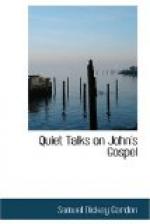There is always a warmth, a gentle radiating comforting drawing warmth in His presence. This is the thing you feel most, the warmth. But it isn’t the only thing. There’s the purity. There are ideals that seem out of reach in their great height. There’s the insistence on these ideals, rigid stern absolutely unbending insistence. You see these. You can’t help it. You feel them tremendously. They seem to leave you clear out of reckoning, they are so high up. But there’s the warmth, drawing arousing wooing, irresistible.
You come to find that the warmth of that presence is as irresistible as the ideals and the insistence are unbending. And the warmth woos you. It warms you, till there come the intense admiration of the ideals, and then the eager reaching of the whole being up towards them.
This is John’s picture of the brooding wooing Jesus. This is God, in human garb as He comes to us in John’s pages. Jesus is God brooding over us to woo out of us the love and purity, the purity and love, that He woos into us by the touch of His own warm presence.
John’s little book is put together as simply as his sentences. And as you take it up, it falls apart almost of itself, so simple and natural are its divisions. We had a look at the opening paragraphs of the Gospel, those eighteen brief verses that open the doorway into all the Gospel holds for us. There is given chiefly John’s simple vivid tremendous picture of a Person, coming with swift long stride and outreached hands.
Now we turn to the second part of the book. It runs from the nineteenth verse of the opening chapter on through to the end of chapter twelve. It is devoted to the great winsome wooing of this great human Person. Here we see Him on His wooing errand. He woos individual men. He gives the personal touch. He devotes Himself to one person, now here, now there. His skill and tact in personal dealing are matchless. But this is not the chief wooing of these pages. It is the nation He is wooing. With rarest strategy and boldness and persistence He lays loving siege to the nation through its leaders. This is central and dominant in all His movements here. This is the second picture in the gallery of John’s Gospel.
It is a good thing to run through these fourteen pages of John’s Gospel several times; to run through rapidly, though not hurriedly; to run through them as a story until it stands out in your mind as one simple connected, story. And then it will help greatly, if you are so blest as to have some boy or girl near at hand to whom you can tell it as a story in simple child (not childish) talk.
Pack the whole into one story of ten minutes, or fifteen: the man of the story;[11] how He tried to win the people’s hearts;[12] how towards the end He spent a long evening with those who loved Him;[13] how awfully He was treated by those who hated Him;[14] then how wondrously He surprised His friends;[15] and then the little bit at the end where He prepares breakfast and has a walk and talk on the seashore with a little group of those who loved Him most.[16]




